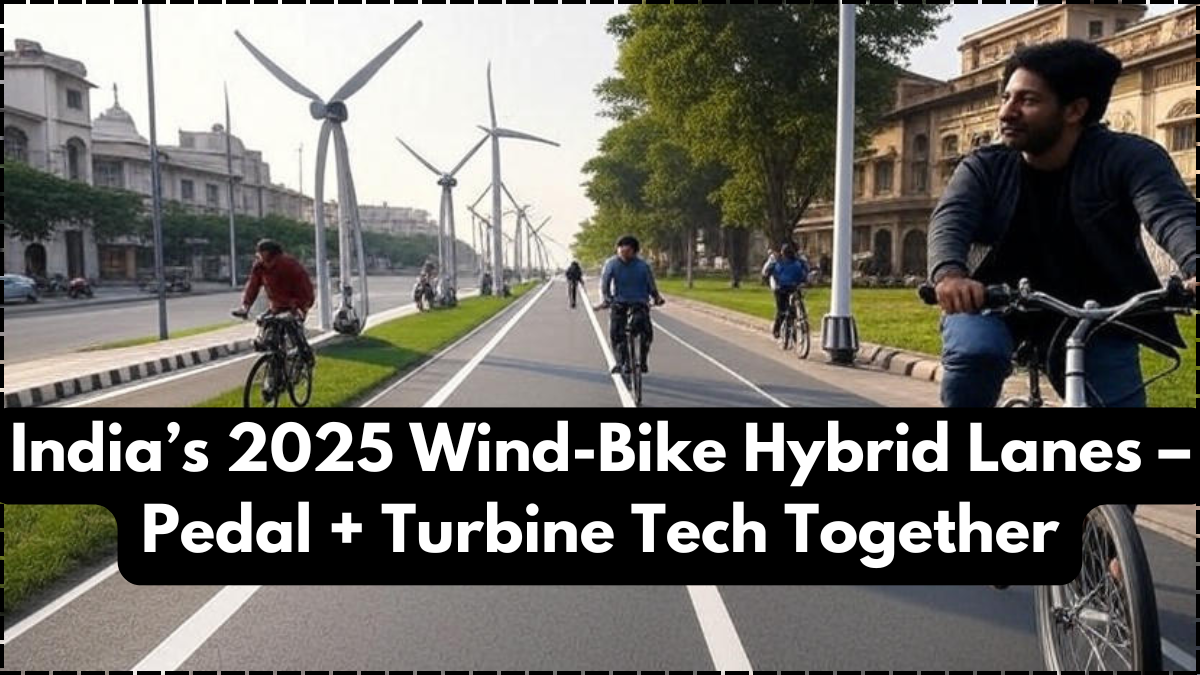Cycling in India has always been associated with health, affordability, and sustainability. But in 2025, the country is taking it to the next level with the introduction of Wind-Bike Hybrid Lanes. These specially designed lanes combine cycling tracks with micro wind turbines that generate clean energy as people pedal along. This project is part of the broader Eco Cycling India initiative, which seeks to merge fitness, renewable power, and eco-friendly transportation into one unified experience.
This innovation is not only about offering a green commute but also about transforming urban and rural mobility. By generating electricity through the motion of bikes and the flow of natural winds, India is setting a global example of how infrastructure can promote both wellness and sustainability.

The Vision of Wind-Bike Hybrid Lanes
The Wind-Bike Hybrid Lanes are more than cycling tracks; they are power-generating ecosystems. Each lane is fitted with wind turbines alongside and embedded systems that capture energy from pedaling bikes. Together, these innovations create a dual source of renewable power.
As part of Eco Cycling India, the government aims to link health benefits with environmental conservation. By encouraging citizens to cycle regularly, not only do they reduce their carbon footprint but also contribute to energy production that can power streetlights, small shops, and even charging stations for electric bikes.
How the Wind-Bike System Works
The combination of turbines and bicycles in the Wind-Bike Hybrid Lanes is based on two principles: human kinetic energy and wind energy. When cyclists ride, sensors in the track capture the motion and convert it into usable electricity. Simultaneously, strategically placed turbines harness wind currents along the lane.
The Eco Cycling India project ensures that the electricity generated is fed directly into local grids, powering essential services. This design promotes a decentralized energy model where each city or village generates its own sustainable power from everyday commuting activities.
Table: Benefits of Wind-Bike Hybrid Lanes
Benefit Area |
Impact of Wind-Bike Hybrid Lanes |
|---|---|
Health & Fitness |
Encourages more people to cycle daily for fitness and wellness |
Renewable Energy |
Generates clean power through turbines and cyclist movement |
Urban Development |
Powers streetlights and small infrastructure with sustainable energy |
Community Participation |
Citizens contribute directly to energy production while commuting |
Environment |
Supports Eco Cycling India by reducing carbon emissions nationwide |
This table highlights how the Wind-Bike Hybrid Lanes create value for individuals, cities, and the environment simultaneously.
Linking Eco Cycling India with Future Mobility
The Eco Cycling India initiative ensures that cycling is not seen as just exercise but as a contribution to national energy goals. These lanes are being introduced in urban cities as well as rural regions, where they serve as an affordable mobility option. Farmers, students, and workers can benefit from reduced transport costs while generating electricity for their communities.
By combining cycling culture with renewable power, Wind-Bike Hybrid Lanes bring innovation to the very streets people use every day. This project also ties into India’s ambition to achieve large-scale clean energy adoption and reduce dependency on fossil fuels.
The Cultural and Environmental Shift
The Wind-Bike Hybrid Lanes are not just a technological solution; they represent a cultural shift in how Indians view mobility and energy. Under the Eco Cycling India banner, people now see cycling as both a personal benefit and a national contribution. Communities gain pride in knowing that their everyday rides help power lights and reduce emissions.
This also encourages tourism and city branding, as such futuristic lanes attract global attention. By merging traditional cycling with cutting-edge turbine technology, India redefines itself as a leader in sustainable infrastructure.
Conclusion
India’s Wind-Bike Hybrid Lanes in 2025 represent a bold step forward in merging health, transportation, and clean energy. Through the Eco Cycling India initiative, these lanes go beyond reducing emissions – they actively produce power while promoting fitness and community participation. This innovation proves that when sustainability meets creativity, everyday actions like cycling can transform into national achievements.
FAQs
What are Wind-Bike Hybrid Lanes?
They are cycling tracks integrated with wind turbines and kinetic energy systems to produce renewable electricity.
How does Eco Cycling India connect with these lanes?
Eco Cycling India is the national initiative promoting cycling as a sustainable lifestyle and linking it with renewable energy production.
Where will these lanes be introduced first?
Major Indian cities and selected rural regions will see the first rollout of Wind-Bike Hybrid Lanes in 2025.
Can the power generated be stored?
Yes, the energy from both wind and cycling can be stored in batteries or sent directly into local grids.
Click here to learn more